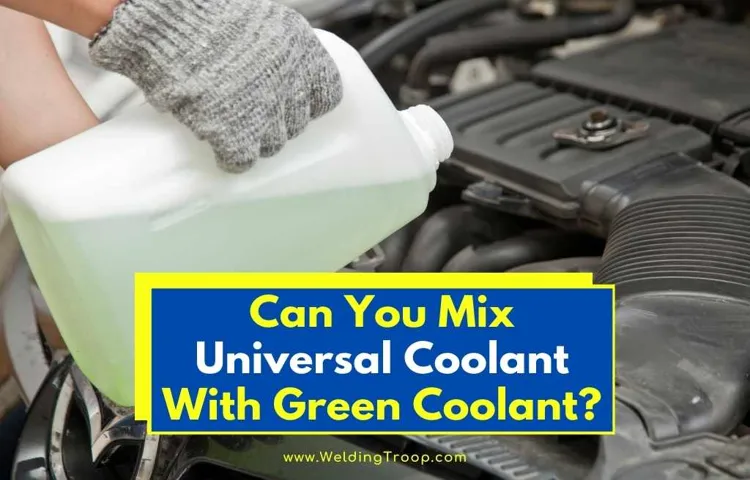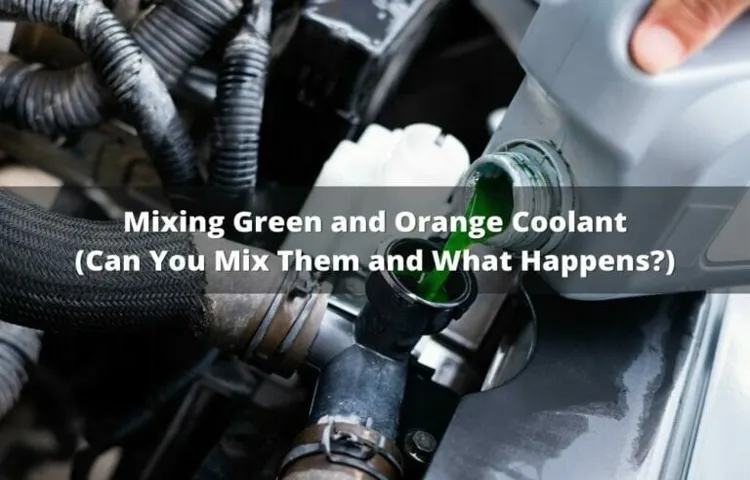What happens when you mix orange and green coolant? It’s a question that many car owners may have pondered. Is it safe to mix these two different coolant colors or would it cause damage to your vehicle’s engine? In this comprehensive explanation, we’ll dive into the world of coolant and explore what happens when orange and green varieties are mixed together. Coolant, also known as antifreeze, is a vital component of a car’s cooling system.
It helps regulate the temperature of the engine by dissipating heat and preventing it from overheating. Coolant is typically made up of water and a mixture of chemicals, including ethylene glycol or propylene glycol. When it comes to coolant colors, there are generally two main types: orange and green.
Orange coolant, also known as Dex-Cool, is commonly found in GM vehicles. It contains an extended-life formula that is designed to last longer and provide better corrosion protection. On the other hand, green coolant, also known as conventional coolant, is the more traditional type and is used in many other vehicles.
Now, what happens if you mix orange and green coolant? The short answer is, it’s not recommended. Mixing different types of coolant can lead to a variety of issues. The main concern is the potential for chemical reactions between the different additives in the coolant.
These reactions can lead to the formation of sludge or gel-like substances that can clog the cooling system and reduce its efficiency. In addition to clogging, mixing coolant colors can also compromise the corrosion protection properties of the coolant. Each type of coolant contains specific additives and inhibitors that are tailored to provide the best protection for the materials used in the cooling system.
When different coolants are mixed, these additives can become less effective, potentially leading to accelerated corrosion and damage to the engine. To avoid any potential problems, it’s always best to stick with one type of coolant recommended by your vehicle’s manufacturer. If you need to top off your coolant or flush the system, make sure to use the same color coolant that is already in your vehicle.
Table of Contents
Introduction
Have you ever wondered what would happen if you mixed orange and green coolant? Well, let me enlighten you. Mixing different coolants is generally not recommended because it can affect the performance and longevity of your vehicle’s cooling system. Each coolant is formulated with specific additives and chemicals that are designed to work best within a certain temperature range.
When you mix different coolants, these additives and chemicals can react with each other, leading to the formation of sludge or gunk that can clog your radiator and reduce heat transfer. This can ultimately result in overheating and potential damage to your engine. So, it’s always best to stick with one type of coolant and follow the manufacturer’s recommendations for your specific vehicle.
Why are orange and green coolants used?
orange and green coolants, coolant colors

What happens when orange and green coolant mix?
“What happens when orange and green coolant mix?” Introduction: Mixing different types of coolant, such as orange and green coolant, can have unintended consequences for your vehicle’s cooling system. Coolant, also known as antifreeze, is a critical component in maintaining the proper operating temperature of your engine. It helps prevent overheating in the summer and freezing in the winter.
While it may be tempting to mix different types of coolant to save money or for convenience, it can lead to significant problems and potentially damage your engine. In this article, we will explore what happens when orange and green coolant mix and why it’s important to stick to one type of coolant for your vehicle.
Effects of Mixing Orange and Green Coolant
If you’re wondering what happens if you mix orange and green coolant in your car, the answer is not as straightforward as you might think. The color of coolant is indicative of the type of antifreeze that is used in the radiator. Orange coolant usually contains organic acids, while green coolant contains inorganic acids.
These acids have different chemical compositions and can react differently when mixed together. Mixing orange and green coolant can result in a variety of consequences, depending on the specific brands and formulations of the coolants. In some cases, the mixture may create a sludgy or gel-like substance that can clog the cooling system and cause overheating.
In other cases, the mixture may cause corrosion and damage to the various components of the cooling system, such as the radiator and water pump. It is generally recommended to consult your vehicle’s manufacturer or a trusted mechanic before mixing different types of coolant, as they can provide guidance and recommendations based on your specific car and coolant type.
Chemical reactions and potential damage to your engine
orange and green coolant, chemical reactions, potential damage, engine, effects, mixing Paragraph: Have you ever wondered what happens when you mix orange and green coolant in your engine? Well, it’s not a good idea, and here’s why. Orange and green coolants are formulated with different types of additives, and when they are mixed together, they can create chemical reactions that can potentially damage your engine. You see, these coolants are designed to work best with specific types of metals, and when they are mixed, the additives can form corrosive substances that can eat away at the metal surfaces inside your engine.
This can lead to leaks, overheating, and overall poor performance. It’s like mixing oil and water – they just don’t mix well together. So, if you want to avoid potential damage to your engine, it’s best to stick with one type of coolant and avoid mixing orange and green coolants.
It’s a simple step that can save you a lot of trouble and costly repairs in the long run.
Compatibility issues with seals and gaskets
orange and green coolant, compatibility issues, seals and gaskets
Potential for reduced coolant effectiveness
Mixing orange and green coolant can potentially reduce the effectiveness of your coolant system. Coolant, also known as antifreeze, plays a crucial role in maintaining the proper temperature of your engine. It helps prevent overheating by absorbing and dissipating the excess heat generated during the combustion process.
Orange and green coolants are typically made with different types of additives and inhibitors. While both are designed to protect against corrosion, they may not be compatible when mixed together. When these coolants are mixed, it can lead to the formation of harmful chemical reactions, resulting in a loss of their protective properties.
Furthermore, orange and green coolants have different base fluids. Orange coolants are often made with an ethylene glycol base, while green coolants usually contain a mix of ethylene glycol and other organic acids. These different base fluids interact differently with the metal surfaces in your cooling system, which can lead to further corrosion and decreased effectiveness.
In addition to reduced coolant effectiveness, mixing orange and green coolant can also cause issues with a coolant system’s pH balance. Coolants are designed to maintain a specific pH level, which helps prevent the formation of corrosion-causing acids. When different types of coolants are mixed together, the pH balance can become disrupted, leading to an increased risk of corrosion.
Overall, it is best to stick with the same type of coolant recommended by your vehicle manufacturer. If you need to top off or flush your coolant system, it is important to use a coolant that is compatible with your existing coolant. Consult your vehicle’s owner’s manual or reach out to a professional mechanic for guidance to avoid potential damage to your engine caused by the mixing of orange and green coolant.
Steps to Take If You Accidentally Mix Orange and Green Coolant
Accidentally mixing orange and green coolant can have detrimental effects on your vehicle’s cooling system. These two types of coolant are chemically different and can cause a reaction when combined. Mixing orange and green coolant can result in the formation of sludge and sediment, which can clog your radiator and lead to overheating.
Additionally, it can cause corrosion within the cooling system, leading to leaks and potential damage to important components. To rectify this situation, it is crucial to flush out the mixed coolant and replace it with the appropriate type for your vehicle. It is recommended to consult with a professional mechanic or refer to your vehicle’s manual for further guidance on the specific steps to take in your situation.
Drain and flush the cooling system
coolant, drain and flush, mixing orange and green coolant
Inspect for any damage or leaks
“mix orange and green coolant” Oh no! You’ve accidentally mixed orange and green coolant in your vehicle, and now you’re worried about the consequences. Don’t panic, though – there are a few steps you can take to address this issue. Firstly, it’s important to inspect your vehicle for any immediate damage or leaks.
Mixing different types of coolant can potentially cause a chemical reaction that may damage your engine or cooling system. Look for any signs of coolant leakage, such as puddles underneath your car or a sweet smell. Additionally, check your coolant reservoir and radiator for any discoloration or signs of contamination.
If you don’t notice any immediate damage or leaks, the next step is to drain and flush your cooling system. Begin by removing the lower radiator hose and allow the mixture of orange and green coolant to drain out completely. Once the system is drained, refill it with the coolant recommended by your vehicle’s manufacturer, making sure it matches the color of your vehicle’s original coolant.
After refilling the cooling system, it’s crucial to carefully monitor your vehicle for any issues. Keep a close eye on the temperature gauge and coolant levels. If you notice any signs of overheating or coolant loss, it’s essential to address the problem immediately by having your vehicle inspected by a professional mechanic.
Remember, mixing different types of coolant is not ideal and can potentially cause damage to your vehicle. It’s always best to stick with the recommended coolant for your specific vehicle. However, if you find yourself in a situation where orange and green coolant have been mixed, following these steps can help mitigate any potential damage and ensure the proper functioning of your cooling system.
So, don’t fret if you’ve made the accidental coolant mishap. By inspecting for damage or leaks, draining and flushing your cooling system, and diligently monitoring your vehicle, you can address the issue and get back on the road with peace of mind.
Refill with the correct coolant
If you accidentally mix orange and green coolant in your vehicle, it’s important to take the necessary steps to rectify the situation. The first thing you should do is drain the coolant from the system and thoroughly flush it out with water. This will help remove any traces of the mixed coolant.
Once the system is empty, refill it with the correct coolant for your vehicle. Using the wrong type of coolant can lead to serious damage to your engine, so it’s crucial to use the right one. If you’re unsure about which coolant to use, refer to your vehicle’s owner’s manual or consult a professional mechanic.
By taking these steps, you can ensure that your vehicle’s cooling system is in proper working order and avoid any potential damage caused by the mix of different coolant types.
Conclusion
Well, if you find yourself in the precarious position of mixing orange and green coolant, you may be in for quite the unconventional automotive experiment. Picture this: a daring blend of vibrancy and vitality, an audacious concoction of citrusy zest and leafy freshness. Orange coolant, with its fiery disposition, teams up with green coolant, the epitome of cool and collected.
It’s a meeting of opposites, a veritable collision of chromatic chaos. In practical terms, however, this intermingling of coolants is not as picturesque as one might hope. You see, orange and green coolant are not just different colors; they are formulated with different chemical compositions.
Orange coolant typically contains an organic acid technology (OAT) additive package, while green coolant usually utilizes an inorganic additive technology (IAT). Mixing these two types of coolant can lead to some rather unpleasant outcomes, akin to mixing stripes with plaid—just not a good look. When these dissimilar coolants blend together, a chemical reaction can occur, resulting in the formation of sludge or gel-like substances.
This sludge can clog up your vehicle’s cooling system, hindering its ability to effectively dissipate heat. In essence, your engine may find itself in a sticky situation, struggling to stay cool under the duress of this peculiar coolant misadventure. Moreover, the mixture of orange and green coolant may cause a loss of corrosion protection.
Each coolant is designed to provide adequate anti-corrosion properties for the specific metals found in a particular cooling system. When combined, the corrosion inhibitors in these coolants may become ineffective, leaving components vulnerable to the ravages of rust, erosion, and other degradation. So, while this colorful collision may be a tempting experiment in aesthetic audacity, it’s best to stick with what your manufacturer recommends.
Mixing orange and green coolant is like trying to merge fire and ice—spectacular in theory, disastrous in practice. Keep things cool, both figuratively and literally, and let your coolant systems remain as untangled and harmonious as a jazz ensemble.
FAQs
What happens if you mix orange and green coolant?
Mixing orange and green coolant can result in the formation of a sludgy and gel-like substance. This can clog the coolant passages, leading to overheating of the engine and potential damage. It is best to use the coolant recommended by the manufacturer to avoid such problems.
Is it safe to mix different types of coolant?
It is generally not recommended to mix different types of coolant. Each type has specific properties and additives that may not be compatible with others. Mixing can lead to chemical reactions, loss of effectiveness, and potential engine damage. It’s best to use the same type of coolant or consult the vehicle’s manual for the manufacturer’s recommendations.
Can mixing coolants cause corrosion?
Mixing incompatible coolants can indeed cause corrosion. Different coolants contain various corrosion inhibitors that may react negatively when combined. This can lead to accelerated rusting and corrosion of the cooling system components, potentially resulting in leaks and engine damage.
Will mixing coolants affect the freezing and boiling points?
Mixing coolants of different types can alter the freezing and boiling points. Different coolants have unique formulations, including additives that determine their temperature characteristics. Mixing incompatible coolants can destabilize these properties, compromising the coolant’s ability to protect the engine from freezing or overheating.
Can mixing coolants void the vehicle’s warranty?
Mixing coolants not recommended by the manufacturer can potentially void the vehicle’s warranty. Manufacturers specify the type of coolant to use, as well as any approved alternatives. Deviating from these guidelines may result in engine damage, and the warranty may not cover the costs of repairs caused by using incompatible coolants.
Are all coolants compatible with each other?
No, not all coolants are compatible with each other. Different coolants have distinct chemical compositions and additives that may not be compatible with others. Mixing incompatible coolants can lead to chemical reactions, formation of sludge, and potential damage to the cooling system.
What should I do if I accidentally mix different coolants?
If you accidentally mix different coolants, it is advisable to drain and flush the entire cooling system immediately. This will help remove any sludgy or incompatible mixture that may have formed. After flushing, refill the system with the correct coolant recommended by the vehicle’s manufacturer. Avoid driving the vehicle until the issue is resolved to prevent potential engine damage.



